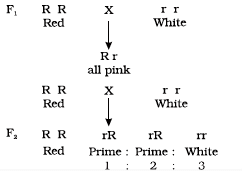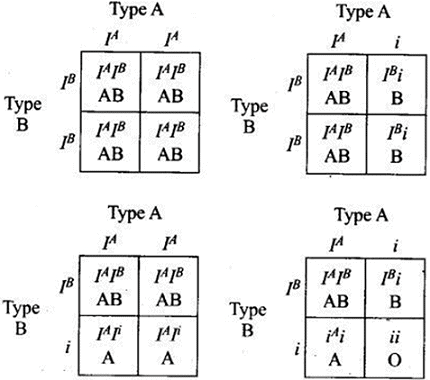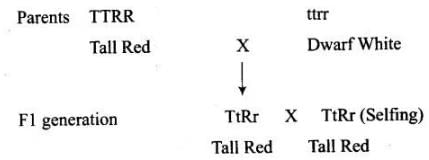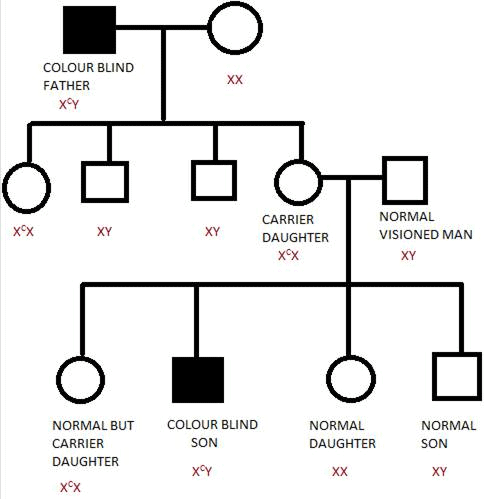NCERT Exemplar: Principles of Inheritance & Variation - 2 | Biology Class 12 - NEET PDF Download
Short Answer Type Questions
Q1. In a Mendelian monohybrid cross, the F2 generation shows identical genotypic and phenotypic ratios. What does it tell us about the nature of alleles involved? Justify your answer.
Ans: In a monohybrid cross, starting with parents which homozygous dominant and homozygous recessive, F1, would be heterozygous for the trait and would express the dominant allele. But in the case of incomplete dominance, a monohybrid cross shows the result as follows.

Phenotypic ratio → Red : Pink : White :: 1 : 2 : 1
Genotypic ratio → RR : Rr: rr : .1:2:1
Here the genotypic and phenotypic ratios are the same. So, we can conclude that when genotypic and phenotypic ratios are the same, the alleles show incomplete dominance.
Q2. Can a child have blood group O if his parents have blood group ‘A’ and ‘B’? Explain.
Ans: If parents are heterozygous then the child can have O blood group but if the parents are homozygous then the child cannot have O blood group.

Q3. What is Down’s syndrome? Give its symptoms and cause. Why is it that the chances of having a child with Down’s syndrome increases if the age of the mother exceeds forty years?
Ans: Down’s syndrome is a human genetic disorder caused due to trisomy of chromosome no. 21. Such individuals are aneuploid and have 47 chromosomes (2n + 1). The symptoms include mental retardation, growth abnormalities, constantly open mouth, dwarfness etc. The reason for the disorder is the non-disjunction (failure to separate) of the homologous chromosome of pair 21 during meiotic division in the ovum. The chances of having a child with Down’s syndrome increase with the age of the mother (+40) because ova are present in females. Since their birth and therefore older cells are more prone to chromosomal non-disjunction because of various physico-chemical exposures during the mother’s lifetime.
Q4. How was it concluded that genes are located on chromosomes?
Ans: Morgan confirmed Mendelian laws of inheritance and the hypothesis that genes are located on chromosomes. Morgan had discovered that eye colour in Drosophila expressed a sex-linked trait. All first-generation offspring of a mutant white-eyed male and a normal red-eyed female would have red eyes because every chromosome pair would contain at least one copy of the X chromosome with the dominant trait.
Q5. A plant with red flowers was crossed with another plant with yellow flowers. If F1 showed all flowers orange in colour, explain the inheritance.
Ans: This is due to the incomplete dominance as the F, do not resemble either of the two parents and is in between the two.

Q6. What are the characteristic features of a true-breeding line?
Ans: A true-breeding line for a trait is one that, has undergone continuous self¬pollination or brother-sister mating, showing stability in the inheritance of the trait for several generations.
Q7. In peas, tallness is dominant over dwarfness, and the red colour of flowers is dominant over the white colour. When a tall plant bearing red flowers was pollinated with a dwarf plant bearing white flowers, the different phenotypic groups were obtained in the progeny in numbers mentioned against them:
Tall, Red = 138
Tall, White = 132
Dwarf, Red = 136
Dwarf, White = 128
Mention the genotypes of the two parents and of the four offspring types.
Ans: The result shows that the four types of offspring are in a ratio of 1:1:1:1. Such a result is observed in a test-cross progeny of a dihybrid cross.
The cross can be represented as:
Tall & Red (Tt Rr) x Dwarf & White (ttrr)
| Offspring | tr |
| Tt Rr - Tall, Red | TR - TtRr - Tall Red |
| Tt rr - Tall, White | Tr - Ttrr - Tall White |
| Tt Rr - Dwarf, Red | tR - ttRr - Dwarf Red |
| tt rr - Dwarf, white | tr - ttrr - Dwarf White |
Q8. Why is the frequency of red-green colour blindness is many times higher in males than that in females?
Ans: For becoming colourblind, the female must have the allele for it in both her X-chromosomes; but males develop colourblindness when their sole X-chromosome has the allele for it.
Q9. If a father and son are both defective in red-green colour vision, is it likely that the son inherited the trait from his father? Comment.
Ans: Gene for colour blindness is X-chromosome linked, and sons receive their sole from their mother, not from their father. Male-to-male inheritances are not possible for X-linked traits in humans. In the given case the mother of the child must be a carrier (heterozygous) for the colour blindness gene.
Q10. Discuss why Drosophila has been used extensively for genetical studies.
Ans: Morgan worked with the tiny fruit flies, Drosophila melanogaster, which were found very suitable for such studies, as:
- They could be grown on a simple synthetic medium (ripe banana) in the laboratory.
- They complete their life cycle in about two weeks.
- A single mating could produce a large number of progeny flies.
- There was a clear differentiation of the sexes—the male and female flies are easily distinguishable.
- It has many types of hereditary, variations that can be seen with low power microscopes.
Q11. How do genes and chromosomes share similarity from the point of view of genetical studies?
Ans: Similarities between Chromosomes and Genes:
- Both occur in pairs.
- Both segregate at the time of gamete formation such that only one of each pair is transmitted to a gamete.
- Independent pairs segregate independently of each other in both.
Q12. What is recombination? Discuss the applications of recombination from the point of view of genetic engineering.
Ans: The formation of new combinations of genes, either by crossing over or independent assortment is called recombination. Alfred Sturtevant used the frequency of recombination between gene pairs on the same chromosome as a measure of the distance between genes and ‘mapped’ their position on the chromosome. Today genetic maps are extensively used as a starting point in the sequencing of whole genomes as was done in the case of the Human Genome Sequencing Project.
Q13. What is artificial selection? Do you think it affects the process of natural selection? How?
Ans: A process in the breeding of organisms by which the scientist chooses to only those forms having certain desirable characteristics is called artificial selection.
- Natural selection is the differential survival and reproduction of individuals due to differences in phenotype. In natural selection, the difference in reproductive success based on a particular trait is driven by natural processes like predators, weather conditions, and environmental constraints.
- Artificial selection is imposed by humans on other organisms. It affects the process of natural selection through changes in environmental conditions.
Q14. With the help of an example differentiate between incomplete dominance and co-dominance.
Ans:
Incomplete Dominance | Co-Dominance | ||
| 1. | Effect of one of the two alleles is more conspicuous | 1. | Effect of both the alleles are equally conspicuous. |
| 2. | It produces a mixture of the expression of two alleles | 2. | There is no mixing of the effect of the two alleles. |
| 3. | The F1 does not resemble either of the parents. | 3. | The F1 resembles both the parents. |
| Example: Flower colour in dog flower | Example: ABO blood grouping in humans | ||
Q15. It is said, that the harmful alleles get eliminated from the population over a period of time, yet sickle cell anaemia is persisting in the human population. Why?
Ans: The harmful alleles get eliminated from the population over a period of time, yet sickle cell anaemia is persisting in the human population because SCA is a harmful condition which is also a potential saviour from malaria.
Those with the benign sickle trait possess resistance to malarial infection. The pathogen that causes the disease spends part of its cycle in the red blood cells and triggers an abnormal drop in oxygen levels in the cell. In carriers, this drop is sufficient to trigger the full sickle-cell reaction, which leads to infected cells being rapidly removed from circulation and strongly limiting the infection’s progress. These individuals have great resistance to infection and have a greater chance of surviving outbreaks. This resistance to infection is the main reason the SCA allele and SCA disease still exist. It is found in the greatest frequency in populations where malaria was and often still is a serious problem.
Long Answer Type Questions
Q1. In a plant, tallness is dominant over dwarfness and red flower is dominant over white. Starting with the parents work out a dihybrid cross. What is the standard dihybrid ratio? Do you think the values would deviate if the two genes in question are interacting with each other?
Ans:
F2 generation
Gametes | TR | Tr | tR | tr |
TR | TTRR tall red | TTRr tall red | TtRR tall red | TtRr tall red |
Tr | TTRr tall red | Ttrr tall white | TtRr tall red | Ttrr tall white |
tR | TtRR tall red | TtRr tall red | ttRR dwarf red | ttRr dwarf red |
tr | TtRr tall red | Ttrr tall white | ttRr dwarf red | ttrr dw arf white |

Yes, the ratio will deviate if the two genes are interacting with each other. In this condition, the genes do not independently assort with each other. So, the ratio will be changed from 9:3:3: 1.
Q2. a. In humans, males are heterogametic and females are homogametic. Explain. Are there any examples where males are homogametic and females heterogametic?
b. Also describe as to, who determines the sex of an unborn child? Mention whether the temperature has a role in sex determination.
Ans:
(a) The term homogametic and heterogametic refer to the organism depending upon whether all the gametes contain one type of sex chromosome (Homo = same) or two different types of sex chromosomes (Hetero = different). Humans show XX/XY type of sex determination, i.e. Females contain two copies of the X chromosome and males contain one X and one Y chromosome. Therefore, ova produced by females contain the same sex chromosome, i.e. X. On the other hand, the sperms contain two different types of chromosomes, i. e. 50% of sperms have X and 50% have Y chromosomes open from half the autosomes (Meiosis). Therefore, the sperms are different with respect to the composition of the sex chromosome. In the case of humans, females are considered to be homogametic while males are heterogametic. Yes, there are examples where males are homogametic and females are heterogametic. In some birds, the mode of sex determination is denoted by ZZ (males) and ZW (females),
(b) As a rule the heterogametic organism determines the sex of the unborn child. In the case of humans, since males are heterogametic it is the father and not the mother who decides the sex of the child. In some animals like crocodiles, lower temperatures favour the hatching of female offspring and higher temperatures lead to the hatching of male offspring.
Q3. A normal visioned woman, whose father is colour blind, marries a normal visioned man. What would be the probability of her sons and daughters being colour blind? Explain with the help of a pedigree chart.
Ans:
 All daughters are normal visioned; 50% of sons are likely to be colour blind.
All daughters are normal visioned; 50% of sons are likely to be colour blind.
Q4. Discuss in detail the contributions of Morgan and Sturvant in the area of genetics.
Ans Experimental verification of the chromosomal theory of inheritance by Thomas Hunt Morgan (Father of experimental genetics) and his colleagues, led to discovering the basis for the variation that sexual reproduction produced. Morgan worked with the tiny fruit flies, Drosophila melanogaster, which were found very suitable for such studies.
- Morgan carried out several dihybrid crosses in Drosophila to study genes that were sex-linked. The crosses were similar to the dihybrid crosses carried out by Mendel in peas. For example, Morgan hybridised yellow-bodied, white-eyed females to brown-bodied, red-eyed males and intercrossed their F, progeny.
- He observed that the two genes did not segregate independently of each other and the F2 ratio deviated very significantly from the. 9 : 3 : 3 : 1 ratio (expected when the two genes are independent). Morgan and his group knew that the genes were located on the X chromosome and saw quickly that when the two genes in a dihybrid cross were situated on the same chromosome, the proportion of parental gene combinations were much higher than the non-parental type.
- Morgan attributed this due to the physical association or linkage of the two genes and coined the term linkage to describe this physical association of genes on a chromosome and the term recombination to describe the generation of non-parental gene combinations.
- His student Alfred Sturtevant used the frequency of recombination between gene pairs on the same chromosome as a measure of the distance between genes and ‘mapped’ their position on the chromosome. Today genetic maps are extensively used as a starting point in the sequencing of whole genomes as was done in the case of the Human Genome Sequencing Project.
Q5. Define aneuploidy. How is it different from polyploidy? Describe the individuals having following chromosomal abnormalities.
a. Trisomy of 21st Chromosome
b. XXY
c. XO
Ans Failure of segregation of chromatids during cell division cycle results in the gain or loss of a chromosome(s), called aneuploidy. – Difference between aneuploidy and polyploidy
1. Failure of segregation of chromatids during cell division cycle results in the gain or loss of a chromosome(s), called aneuploidy. Failure of cytokinesis after telophase stage of cell division results in an increase in a whole set of chromosomes in an organism and,this phenomenon is known as polyploidy.
2. Polyploidy occurs due to altering a set of chromosome numbers such as 2n, 3n, 5n, whereas aneuploidy occurs due to altering a particular chromosome or part of a chromosome such as 2n + 1 (trisomic) and 2n – 1 (monosomic).
3. Aneuploidy can be seen in humans as a genetic disorder; for example, Turner syndrome, Klinefelter syndrome and Down syndrome, whereas polyploidy is common in plants.
(i) Down’s Syndrome (Mongolism)
- The cause of this genetic disorder is the presence of an additional copy of chromosome number 21 (trisomy of 21) due to the non-disjunction of chromosomes during sperm or ova formation.
- The affected individual is short-statured with a small round head, furrowed tongue and partially open mouth. Palm is broad with a characteristic palm crease.
- Physical, psychomotor and mental development is retarded.
(ii) Klinefelter’s Syndrome
- This genetic disorder is also caused due to the presence of an additional copy of X-chromosome resulting in a karyotype of 47, XXY.
- Such an individual has overall masculine development, however, the feminine development (development of breast, i.e., Gynaecomastia) is also expressed. Such individuals are sterile males.
(iii) Turner’s Syndrome
Such a disorder is caused due to the absence of one of the X chromosomes, i.e., 45 with XO. Such females are sterile as ovaries are rudimentary besides other features including lack of other secondary sexual characters.
|
78 videos|280 docs|174 tests
|
FAQs on NCERT Exemplar: Principles of Inheritance & Variation - 2 - Biology Class 12 - NEET
| 1. What are the principles of inheritance and variation? |  |
| 2. What is the role of DNA in inheritance and variation? |  |
| 3. How are genetic variations responsible for evolution? |  |
| 4. What is the significance of Mendel's experiments in understanding inheritance and variation? |  |
| 5. How do genetic disorders result from inheritance and variation? |  |
































